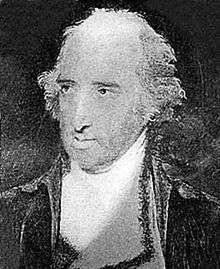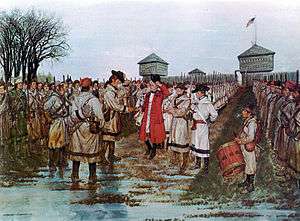Henry Hamilton (colonial administrator)
Henry Hamilton (c. 1734 – 29 September 1796) was an Anglo-Irish military officer and later government official of the British Empire. He served in North America as Lieutenant Governor of the Province of Quebec and later as Deputy Governor after the Revolutionary War. He later served as Governor of Bermuda and lastly, as Governor of Dominica, where he died in office.
Henry Hamilton | |
|---|---|
 Portrait of Governor Henry Hamilton | |
| Born | c. 1734 Dublin, Ireland |
| Died | 29 September 1796 (age 62) |
| Nationality | British |
| Other names | Hair Buyer, Hair-buyer General |
| Occupation | soldier, army officer, governor |
| Spouse(s) | Elizabeth Lee |
| Children | Mary Anne Pierpoint Hamilton (daughter) |
| Parent(s) | Henry Hamilton |
| Relatives | Sackville Hamilton (brother) |
Hamilton was captured in 1779 by rebel forces at Fort Sackville in present-day Indiana, during the American Revolutionary War, while serving as the Lieutenant Governor and Superintendent of Indian Affairs, at the British outpost of Fort Detroit. He was transported to Virginia, where he was held by Governor Thomas Jefferson's rebel government until October 1780. He was sent to New York and gained freedom in a prisoner exchange in 1781, being allowed to depart for London, England.
Early life
Henry was probably born in Dublin, Ireland. a younger son of Henry Hamilton, an Irish Member of Parliament, and his wife.
Hamilton was raised in County Cork, Ireland. His older brother Sackville Hamilton later served as a Privy Councillor and Under-Secretary to the Lord Lieutenant of Ireland. His direct paternal Great-great grandfather was Claud Hamilton, 1st Lord Paisley.
Military career
As was typical of younger sons, Henry Hamilton entered the military. During the French and Indian War in North America, part of the Seven Years' War between Britain and France, he served as a Captain in the 15th Regiment of Foot. They fought in the 1758 attack on Louisbourg and the Battle of Quebec.[1] With the support of Governor General of British North America Guy Carleton, Hamilton rose to the rank of brigade major. In 1775, he sold his commission, leaving the British Army for a political career.
American Revolutionary War
Lieutenant Governor and Superintendent of Indian Affairs at Fort Detroit
In 1775, Henry Hamilton was appointed as Lieutenant Governor and Superintendent of Indian Affairs at Fort Detroit, Province of Quebec (it then extended from the Atlantic to this area), British North America. (The fort site is now within the borders of Detroit, Michigan).
This was one of five newly created lieutenant governorships in the recently expanded eastern territory of Canada. When Governor Hamilton reached his base at Fort Detroit to assume his government duties in the Great Lakes region, the American Revolutionary War was already underway. Hamilton was in a difficult position: as a civil official, he had few British regular troops at his command, and the natives of the region—French Canadians and American Indians—were not all supporters of the British regime. Normand Macleod, a local fur trader and army officer, acted as the temporary "town major", a British government official in command of a fortified town, before Hamilton's arrival.[2]
British war policies on the western frontier
Governor Henry Hamilton became adept at diplomacy with Native Americans, establishing good relations with local Indian leaders of the Huron and Ottawa tribes. An amateur artist, Hamilton also sketched portraits of many Native Americans while in Detroit, leaving what has been called the "earliest and largest collection of life portraits of Native Americans of the Upper Great Lakes." This is now held by Houghton Library at Harvard University.[3]
At the beginning of the war, British policy encouraged neutrality among the Native American leaders. But in 1777 Hamilton received instructions to encourage Indian raid and massacre against the American frontier settlements in Pennsylvania, Virginia, and Kentucky.
This was a controversial policy, because he and other officials realized that Loyalist civilian colonists would inevitably be killed in these raids, increasing resistance to the British. Hamilton tried to limit civilian casualties by sending British Army officers and French-Canadian militia with the Native American war parties. Despite this the Indian tribal warriors carried out their own customs during the raids, resulting in hundreds of women and children in Kentucky and western Pennsylvania being killed and ritually scalped during the war. This, as feared, led to an increase in anti-British feeling in the land. According to an early 20th-century local history, the frontier Americans believed that Hamilton paid bounties for prisoners and scalps brought in by the Indian warriors and hated him, calling him the "Hair-buyer General".[4] Hamilton denied ever paying for scalps.

George Rogers Clark and Illinois Regiment, Virginia state forces in the Illinois Country
In 1778, Patriot Colonel George Rogers Clark, commanding Virginia state forces, captured several undermanned British posts in the Illinois Country, including Fort Sackville[5] at Vincennes (then in Virginia-claimed land, now in present-day Indiana). Hamilton led an armed party from Detroit on 7 October 1778[6] to recapture the British post, 600 miles away. His small force gathered Indian warriors along the way, and entered Vincennes on 17 December 1778. They captured Fort Sackville and the American commandant, Captain Leonard Helm.[7] In February 1779, however, Colonel Clark returned to Vincennes in a surprise march, recapturing the outpost and taking Hamilton prisoner.
Defeat and prisoner in Virginia
General George Rogers Clark sent Hamilton to the Virginia state capital in Williamsburg, where he was jailed and placed in irons by order of Governor Thomas Jefferson and the Virginia Executive Council. Hamilton was held from 16 June – September 29, 1779. Hamilton rejected an offer of parole on the grounds that the terms violated his freedom of speech, in restraining him from "saying anything to the prejudice of the United States." Jefferson refused to treat Hamilton and other British prisoners as prisoners-of-war and handled them as would have handled escaped slaves; putting them in irons for 18 months in Williamsburg and Chesterfield. Governor Jefferson did not release Hamilton until October 1780, and only after George Washington during several months had entreated him to accept his parole. Hamilton was sent to New York to await a prisoner exchange. This took place in March 1781. He immediately sailed to London, England on a British ship.
Later career as British royal governor
After the war, Henry Hamilton was reassigned to Canada in 1782 under an appointment as Lieutenant-Governor, and later Deputy-Governor of the Province of Quebec. He administered during the transition in the postwar years as the Crown granted thousands of acres of land, mostly in what became Upper Canada, to Loyalists as compensation for their losses in the former Thirteen Colonies and as payment to soldiers.
After a few years, Hamilton was reassigned as royal Governor of Bermuda, serving from 1785 to 1794. He then departed Bermuda on HMS Scorpion (stopping enroute at Antigua on 4 December, 1794)to serve as Governor of Dominica, the present-day Commonwealth of Dominica, from 1794 until his death in office in 1796.[8] In March 1795, at age 61, Hamilton married 25-year-old Elizabeth Lee from Banbury, Oxfordshire, a daughter of Colonel Lee. The Hamiltons had one daughter together, Mary Anne Pierpoint Hamilton. She died in 1871, unmarried and without children.[8]
Death
Hamilton died in office on the island of Antigua, British North America, now Antigua and Barbuda, on 29 September 1796.
Among his papers, Hamilton had kept a journal from 1778-1779 as Lieutenant Governor at Fort Detroit during the American Revolution; this was published for the first time posthumously in 1951 in a history that addressed his and George Rogers Clark's roles in the war.[9]
In popular culture
US author Winston Churchill wrote an epic historical novel in 1904 called The Crossing covering a man's life in the old Northwest from the Revolution to the Burr Conspiracy. The first part is about the protagonist marching as a drummer boy with George Rogers Clark and the highlight is the capture of Vincennes from Hamilton. There is much information about Hamilton's activities and his reputation among the local backwoodsmen, based on research from original documents.
References
- Derleth, August (1968). Vincennes: Portal to The West. Englewood Cliffs, NJ: Prentice-Hall, Inc. p. 55. LCCN 68020537.
- Macleod, Normand. Detroit to Fort Sackville, 1778–1779, Detroit: Burton Historical Collection, Detroit Public Library, 1778, pp. x–xiii
- "Henry Hamilton drawings of North American scenes and Native Americans: Guide". Cambridge: Houghton Library, Harvard College Library. 2009. Retrieved 8 March 2012.
- Greene, George E. (1911). History of Old Vincennes and Knox County, Indiana, Volume 1. S.J. Clarke Publishing Company. p. 182. Retrieved 10 December 2016.
- Fort Sackville was named in honor of George Germain, 1st Viscount Sackville.
- Skaggs, 182
- Skaggs, 183
- "Hamilton, Henry, d.1796. Henry Hamilton drawings of North American scenes and Native Americans: Guide". Cambridge: Harvard University. 2001. Retrieved 1 February 2011.
- Barnhart, John D. Henry Hamilton and George Rogers Clark in the American Revolution, with the Unpublished Journal of Lieut. Governor Henry Hamilton. Crawfordville, Indiana: Banta, 1951
- Arthur, Elizabeth (1979). "Hamilton, Henry". In Halpenny, Francess G (ed.). Dictionary of Canadian Biography. IV (1771–1800) (online ed.). University of Toronto Press.
- Sheehan, Bernard W. "'The Famous Hair Buyer General': Henry Hamilton, George Rogers Clark, and the American Indian," Indiana Magazine of History 69 (March 1983): 1–28.
- Skaggs, David Curtis, ed. (1977). The Old Northwest in the American Revolution. Madison, Wisconsin: The State Historical Society of Wisconsin. ISBN 0-87020-164-6.
External links
| Wikimedia Commons has media related to Henry Hamilton (governor). |
- "Henry Hamilton's Journal", 1778–1779, Indiana Historical Bureau